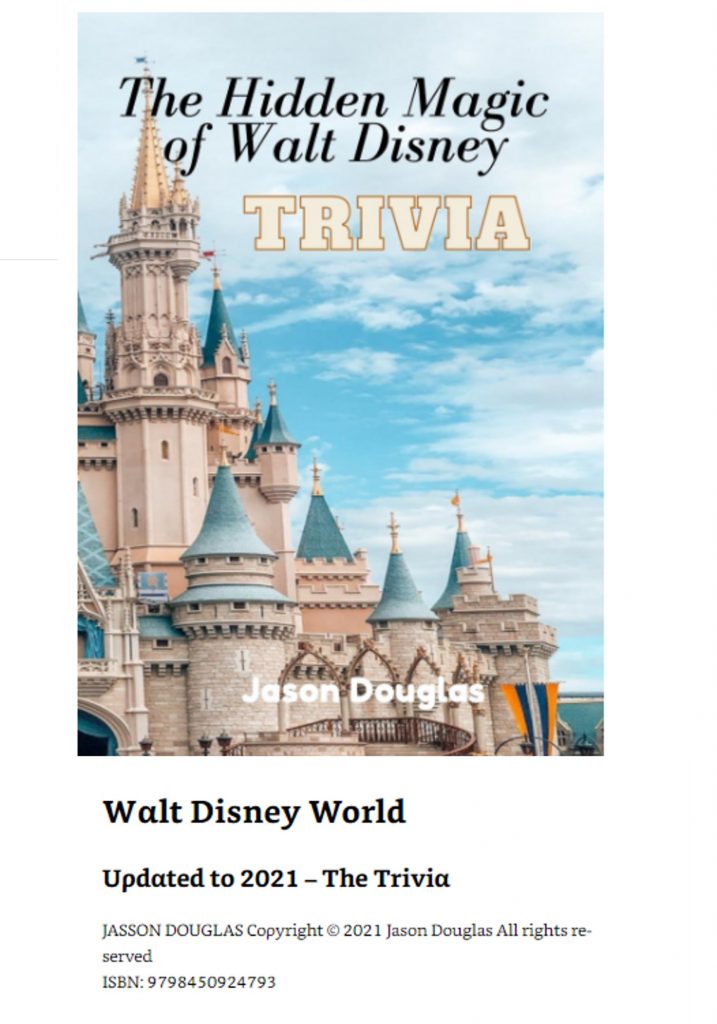Category — A Friday Visit with Jim Korkis
Fridays with Jim Korkis: The Demolition of 20,000 Leagues Under the Sea
Welcome back to Fridays with Jim Korkis! Jim, the dean of Disney historians, writes about Walt Disney World history every Friday on yourfirstvisit.net.
THE DEMOLITION OF 20,000 LEAGUES UNDER THE SEA
By Jim Korkis
Because of the popularity of the Submarine Voyage attraction at Disneyland, it was decided to include it as an opening attraction for Walt Disney World, but with tweaks to reflect the Jules Verne inspired live action Disney film 20,000 Leagues Under the Sea. The Verne theme made the attraction appropriate to be located in Fantasyland rather than Tomorrowland, its Disneyland home.
20,000 Leagues Under the Sea remained popular throughout its first two decades, but it became increasingly apparent that it had limited capacity compared to the expense to maintain and operate it. In addition, water leaking into the lower-level utilidoors, updates to make the ride ADA compliant, and corrosion of mechanical parts made the decision to close it necessary.
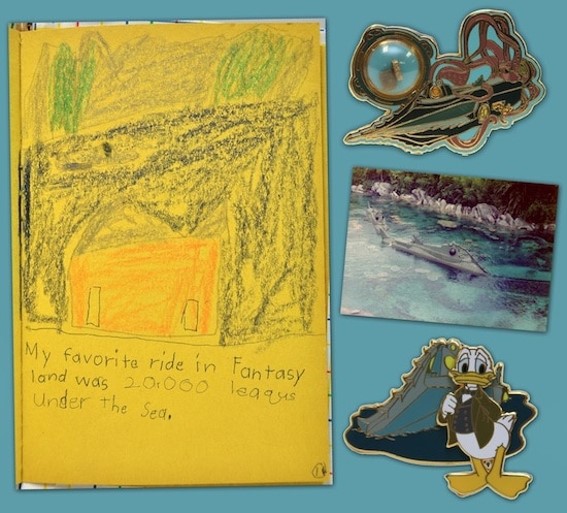
(c) Disney
20,000 Leagues Under the Sea closed on September 5, 1994 without advance notice. Walt Disney World claimed it was closed temporarily for maintenance and would reopen in the summer of 1996. In April of that year, it was announced the closure was permanent.
The submarines were moved around to several different backstage locations at Walt Disney World for several years until they were eventually stripped of items that were auctioned off and the hulls buried in landfill around 2004. Three of the vehicles were saved. Two ended up in the snorkeling lagoon at Castaway Cay but only one survives there today, with both its wheelhouse and dorsal fin destroyed by hurricane weather.
The third vehicle was on display on the backlot tour at Disney MGM Studios and then later put in storage to be used at events like conventions.
Full demolition of the former site of the ride began in 2004 behind construction walls. Adrienne Messenger, Assistant Development Manager at Walt Disney Imagineering, stated, “The project will take several months to complete. The first thing we have to do is take down the ride building and enough rockwork so trucks can get in and out of the lagoon.
“After that, everything in the lagoon comes out. Only the north wall and east wall of the ride building will remain as retaining walls. Backhoes will chip the volcanic rockwork apart, and a special machine will demolish the ride building.
“Crews salvaged reusable show props when the attraction first closed and Horticulture cast members will redistribute existing landscape materials within the theme park and backstage areas.
“Next, we’ll bring in truckloads of earth, about 70,000 cubic yards, compact it, grade it and then we’ll add plants and irrigation. We’re adding some fencing and lights to replace what we’ve removed. When the walls come down, you’ll see a four-to-six foot berm all the way around what used to be the lagoon.”
The work did not effect Ariel’s Grotto with the King Triton spouting fountain or the nearby utilidor. The major challenge according to Messenger was “We’re in Park 2, which is where all the Magic Kingdom Cast comes in to work. There’s not much of a road, and we’re working Third Shift, so there are deliveries coming to the utilidor and Mickey’s Toon Town Fair gate.
“Getting in and out, when you’re talking a hundred loads of debris going out every night, is extremely challenging.”
Once all the water was drained, Pooh’s Playful Spot was built on the area and operated from September 2005 to April 2010. As a tribute to the 20,000 Leagues Under the Sea attraction, a knothole in the shape of the Nautilus submaine was carved into the inside upper arch of the treehouse doorway.
About a month after the playground closed, Disney brought in a crane to move the impressive 120-ton tree a short distance to become part of a new exterior for The Many Adventures of Winnie the Pooh attraction.
* * * * *
Thanks, Jim! And come back next Friday for more from Jim Korkis!
In the meantime, check out his books, including his new books Vault of Walt: Volume 10: Final Edition, Kungaloosh! The Mythic Jungles of Walt Disney World and Hidden Treasures of Walt Disney World Resorts: Histories, Mysteries, and Theming, much of which was first published on this site.
Follow yourfirstvisit.net on Facebook or Twitter or Pinterest!!
April 22, 2022 No Comments
Fridays with Jim Korkis: GI JOE Exclusives at Walt Disney World
Welcome back to Fridays with Jim Korkis! Jim, the dean of Disney historians, writes about Walt Disney World history every Friday on yourfirstvisit.net.
EXCLUSIVE WALT DISEY WORLD GI JOE ACTION FIGURES
By Jim Korkis
Released in August 2001 as part of a Disney Parks worldwide exclusive were five 4.5″ sized action figures from characters featured in the movie Raiders of the Lost Ark (Indiana Jones, Marion Ravenwood, German soldier, German mechanic and Cairo swordsman), and some playsets.
In 2007, a seven inch tall Indiana Jones figure was sculpted by Gentle Giant exclusive for the Disney Theme Parks in the United States. It had fourteen points of articulation: neck, two shoulders, two arms, two hands, torso, two hips, two knees and two ankles. It included the following accessories: fedora, revolver, whip, shoulder bag, sword, golden idol, poison antidote, grail diary, and a base.
All of these figures and items were based on the popular Indiana Jones adventure movies, primarily Raiders of the Lost Ark. However, there was one Indy figure that was exclusively designed for Walt Disney World.

The figure was twelve inches in height and fully poseable. It was available at the Fantasia shop at the Contemporary Resort and the Once Upon A Toy store at Downtown Disney Marketplace.
The convention featured a special display of historical G.I. JOE figures from the previous forty years, seminars focusing on G.I. JOE artwork, comic books and action figures, G.I. JOE merchandise sales areas, diorama-building and photography contests, a “play pit” for kids, and more. It cost nine dollars for adults and five dollars for children to attend the public events.
While Walt Disney World did not sponsor the convention, it did support the celebration with the on-property debut of the Walt Disney World themed G.I. JOE figure, priced at forty dollars.
The following month saw the debut of a limited edition G.I. JOE Mission: SPACE figure that included an astronaut spacesuit and helmet, an oxygen backpack, hoses to connect the pack to the helmet, and nine different pieces of equipment for JOE’s mission on Mars.
The gear attached to JOE’s chest featured a representation of the Mission SPACE logo, and the shoulder patch read ISTC (the International Space Training Center). The back of the box depicted the X2 rocket, the same ship from the attraction, blasting its way towards the red planet. Hasbro Inc., owner of the G.I. JOE brand, was a Corporate Alliance partner at the Walt Disney World Resort.
The Indiana Jones figure was a Classic Collection GI JOE and came in either Caucasian or African-American colors and head sculpts. The Caucasian head sculpt was the traditional WWII head with its hair in black. The African-American sculpt was a fairly new option for Hasbro.
The reason why they also released an African-American version of this figure is because one of the Indy stunt performers at the Epic Stunt Spectacular was also African-American and both Walt Disney World and Hasbro wanted to support diversity. Interestingly, the Mission: SPACE figure also came with the two different options.
The accessories for the figure included a fedora, short boots, a belt with a metal buckle, a ream-yellow shirt, a “leather” jacket, red/brown pants, a whip, green satchel with strap, a torch, a sarcophagus and mummy with raising arm (previously used in the Adventure Team Secret of the Mummy’s Tomb set), three gems (blue, red and yellow), and three black snakes.
Of particular interest, the back of the jacket had the Indiana Jones Epic Stunt Spectacular logo on it.
* * * * *
Thanks, Jim! And come back next Friday for more from Jim Korkis!
In the meantime, check out his books, including his new books Vault of Walt: Volume 10: Final Edition, Kungaloosh! The Mythic Jungles of Walt Disney World and Hidden Treasures of Walt Disney World Resorts: Histories, Mysteries, and Theming, much of which was first published on this site.
Follow yourfirstvisit.net on Facebook or Twitter or Pinterest!!
April 15, 2022 No Comments
Fridays with Jim Korkis: T-Rex: a Prehistoric Family Adventure
Welcome back to Fridays with Jim Korkis! Jim, the dean of Disney historians, writes about Walt Disney World history every Friday on yourfirstvisit.net.
T-REX: A PREHISTORIC FAMILY ADVENTURE
By Jim Korkis
T-Rex: a Prehistoric Family Adventure is a themed restaurant developed by Schussler Creative, Inc. and operated by Landry’s Restaurants that opened on October 14, 2008 in the area that later became Disney Springs.
Steve Schussler, who at the time was also responsible for creating the Rainforest Café and Yak and Yeti at Disney’s Animal Kingdom, stated “It will be a great place to eat, shop, explore and discover. It’s exciting that something has been built that has all the creativity and ingenuity of an interactive, educational experience that hasn’t been done before.
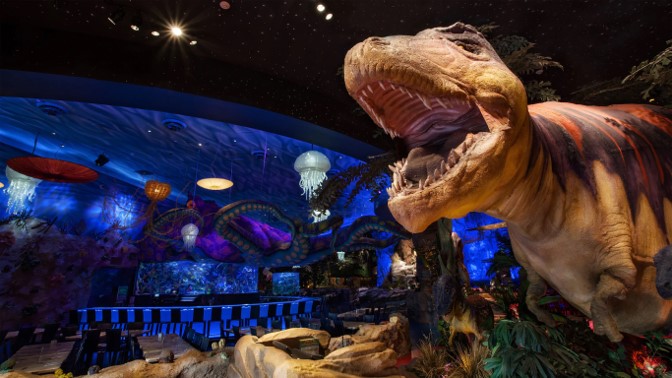
(c) Disney
“That’s what really excites me and my team. People will come first for the ‘wow’ factor but they will come back for quality food and service.”
Outside the restaurant is a full-sized replica of an Argentinosaurus at 125 feet long and 28 feet tall, reputably one of the largest dinosaurs to ever exist. Nearby, a parasaurolophus sits in a pond fed by a waterfall with some prehistoric looking plants by it. Inside is a 45 foot long Tyrannosaurus Rex, the largest of the many audio animatronics dinosaurs inside the restaurant.
The interior is based off of a water, fire and ice concept decorated with fossils and large chunks of amethyst.
“It’s a pretty amazing collection of artifacts,” said Keith Bradford, who at the time was vice president of WDW Operating Participants. “Historically and archeologically, it is all correct, so it is a true museum in that sense. It is a true educational experience.”
Each room in T-Rex: a Prehistoric Family Adventure is unique. The Ice Cave has a life-sized fossil replica of a Tyrannosaurus Rex, an aqua bar with a 5,000 gallon shark tank and a 37 foot octopus with movable tentacles overhead and hanging jellyfish light fixtures. The area also resurrects the woolly mammoth.
The Geothermal region houses the Kitchen of Fire with an open kitchen featuring a giant rotisserie that allows visitors to see meals being prepared. The Fern Forest and Sequoia rooms are the most serene, with canopies of flowers overhead and a docile Triceratops with its infants.
The entire 30,000 square foot restaurant provides seating for over 600. The tables feature designs resembling imprint fossils of fish and other small prehistoric relics. Even the restrooms (She-Rex and He-Rex) are decorated with ancient artifacts.
A two minute long meteor shower comes through each room every twenty minutes amidst waterfalls, bubbling geysers and a fossil dig site, signaling impeding doom for the dinosaurs. The lighting changes, prehistoric animals cry out in alarm and there is a sense of chaos. Even the ice cave seems to start melting.
The PaleoZone offers young guests kids the opportunity to dig for fossils and treasures and check out interactive displays to learn about the creatures in the restaurant. They can play games, watch toon clips, split a geode open, and more. For the menu offerings, creative names in keeping with the prehistoric theme of the restaurant describe tempting food options.
Among the other figures in the restaurant are Apatosaurus, Albertosaure, Stegosaurus, Arthropleura, pterosaurs (including Pteranodon and Rhamphorhynchus), large insects and more.
Attached to the restaurant is a gift shop where guests can build their own dinosaur in partnership with the Build-A-Bear Workshop.
* * * * *
Thanks, Jim! And come back next Friday for more from Jim Korkis!
In the meantime, check out his books, including his new books Vault of Walt: Volume 10: Final Edition, Kungaloosh! The Mythic Jungles of Walt Disney World and Hidden Treasures of Walt Disney World Resorts: Histories, Mysteries, and Theming, much of which was first published on this site.
Follow yourfirstvisit.net on Facebook or Twitter or Pinterest!!
April 8, 2022 No Comments
Fridays with Jim Korkis: The Main Street Emporium Gallery
Welcome back to Fridays with Jim Korkis! Jim, the dean of Disney historians, writes about Walt Disney World history every Friday on yourfirstvisit.net.
THE MAIN STREET EMPORIUM GALLERY
By Jim Korkis
The Main Street Emporium Gallery is the official name of the 2001 expansion of the Main Street Emporium into Center Street.
The expansion resulted in the replacement of the Hallmark Card Shop/Disney Clothiers and New Century Clock Shop, and the relocation of the Harmony Barber Shop. The entire west side of Main Street is now known as “the Emporium complex” rather than by individual store names.
The expansion added 4,600 square feet of retail space and featured an interior themed with crown molding, detailed wood columns, stained glass and an eighteen foot high ceiling. The “debut” of the store in 1901 references the birth year of Walt Disney.
On the back wall, a large mural displays happy customers and employees enjoying their shopping experience at the Emporium Gallery. In actuality, the mural depicts a number Imagineers who were responsible for the design, story, and execution of this addition.
One portrait is of Joyce Carlson, and can be found in the lower left corner of the painting. Carlson was a beloved and legendary Walt Disney World Imagineer who began her career in the Ink and Paint Department at the Disney Studios and was moved to Imagineering to work on the 1964 New York World’s Fair. In particular, she worked closely with Imagineer Mary Blair on the original it’s a small world attraction.
The Imagineering back story for the Emporium is that it started in what is now the center of the building as shown by the early gas lighting chandelier fixture and the wall support posts. It expanded to Center Street, the first street in the city as shown by its bricks rather than paving. In reality, those bricks were salvaged from a turn-of-the-century building being torn down in Orlando when Walt Disney World was being built.
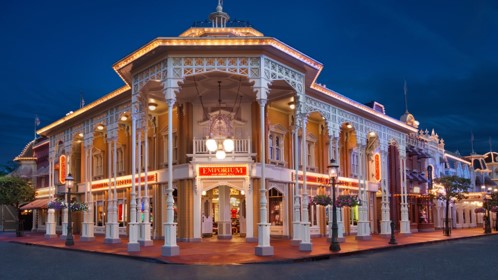
“The storyline is that the proprietor of the Emporium has continued to have such huge success that he wanted to expand his shop, but with no where left to expand, he made arrangements with the city to purchase part of Center Street,” stated Rhonda Counts, Magic Kingdom art director for Walt Disney Imagineering.
“The original Emporium was built in the 1800s and the expansion is being built in the early 1900s so you’re using an Edwardian style that was used in that day that is less ornate than Victorian with lighter colored wood and pastels.”
The expansion was controversial because it destroyed West Center Street. The purpose of Center Street was to “break up” Main Street so guests did not feel it was just one long block of buildings but a city. In addition, West Center Street’s narrow alley-like appearance curved at the end to give the impression that the road and the city itself continued out of sight.
When the new structure was built it was inset into the street, something that would not have been done at the time. It would have been flush with the street to attract traffic. The new addition sold the exact same goods that could be purchased in the Emporium and elsewhere on Walt Disney World property and were not unique to the location.
However, from a business standpoint, the new building was able to monetize previously unused square footage and to connect all the buildings to provide inside access down the entire street for guests.
* * * * *
Thanks, Jim! And come back next Friday for more from Jim Korkis!
In the meantime, check out his books, including his new books Vault of Walt: Volume 10: Final Edition, Kungaloosh! The Mythic Jungles of Walt Disney World and Hidden Treasures of Walt Disney World Resorts: Histories, Mysteries, and Theming, much of which was first published on this site.
Follow yourfirstvisit.net on Facebook or Twitter or Pinterest!!
April 1, 2022 No Comments
Fridays with Jim Korkis: The Hidden Magic of Walt Disney Trivia
Welcome back to Fridays with Jim Korkis! Jim, the dean of Disney historians, writes about Walt Disney World history every Friday on yourfirstvisit.net.
YOUR PERSONAL DISNEY LIBRARY (50)
By Jim Korkis
- The Hidden Magic of Walt Disney Trivia by Jason Douglas
The title on the cover of the book, and as listed on Amazon, is The Hidden Magic of Walt Disney Trivia but the book is entirely about Walt Disney World, and I am assuming this is a self-published book since the interior page lists the author as “Jasson” indicating it was “self edited” and not too carefully.
There are 290 unnumbered pages, no Table of Contents, no illustrations or photos and no Index. Good luck trying to find something. I am unfamiliar with the author and there is no information in the book or on its cover about him.
I really wanted to like The Hidden Magic of Walt Disney Trivia since I like the overall concept and the variety but it just comes across as disorganized and it takes a lot of effort to find the virtues. It is definitely not designed to be reader-friendly, and I found myself feeling frustrated, especially when after reading it I tried to find some specific things I wanted to talk about in this review. There was just no easy way to locate that information.
In theory, the book is divided into four lengthy chapters with each one representing one of the WDW theme parks–and only the theme parks, no resorts or other things on WDW property. Within each chapter there are two page sections devoted to a single attraction. Once again, these appear in no coherent order and not all attractions are included.
Each two page section has a short paragraph introduction, followed by a four-choice multiple choice question and a second question that requires a short answer. Then there is a paragraph with a “Fascinating Fact” and a paragraph of something to “Look For” at that attraction.
At the end of each complete chapter is a ten item scavenger hunt for that particular park. At the end of the book are additional Kids (and Kids at Heart) Scavenger Hunts. The end of the book has the answer to all the questions as well as the answers to the scavenger hunts. However, the layout is wonky at best and suddenly there will be huge blank sections between the answers especially in the Epcot section.
For the most part, the information is accurate (taking into consideration that things at WDW constantly change) and I found some of the information quite clever, but again too much of that is completely “lost” in the lack of the book’s organization. It seemed a bit odd that there were only two questions per attraction and I would have liked to have seen a bit of explanation, especially for the “short answer” questions, in the Answer Key.
These days almost anyone can publish a book about Disney but with that independence comes the responsibility to edit carefully and to be empathetic and respectful of the reader.
Again, I wanted very much to like this book and be able to recommend it to others. There is indeed some good stuff between the covers but its presentation is confusing and irritating. It is like some of those cooking shows on the Food Network where the chef has prepared something tasty but the presentation is sloppy and unappealing, so he is eliminated from the competition.
* * * * *
Thanks, Jim! There’s a different book, published in 2013, with the more natural title for Douglas’s book of The Hidden Magic of Walt Disney World Trivia, this one by Susan Veness. Given the number and quality of the reviews of her book, it might be a better choice…
And come back next Friday for more from Jim Korkis!
In the meantime, check out his books, including his new books Vault of Walt: Volume 10: Final Edition, Kungaloosh! The Mythic Jungles of Walt Disney World and Hidden Treasures of Walt Disney World Resorts: Histories, Mysteries, and Theming, much of which was first published on this site.
Follow yourfirstvisit.net on Facebook or Twitter or Pinterest!!
March 25, 2022 No Comments
Fridays with Jim Korkis: Walt Disney World Fireworks
Welcome back to Fridays with Jim Korkis! Jim, the dean of Disney historians, writes about Walt Disney World history every Friday on yourfirstvisit.net.
WALT DISNEY WORLD FIREWORKS
By Jim Korkis
The Walt Disney Company is the largest consumer of fireworks in the world (and the second largest purchaser of explosive devices, right behind the U.S. Department of Defense), deploying well over a million individual fireworks annually. Epcot alone uses over 750 shells every night in its show.
Disney has never issued information about what it spends on fireworks shows but it has been estimated that just the Magic Kingdom shows alone would cost conservatively fifteen million dollars annually.
While Disney guests spend a great deal of time and research trying to strategize the best time and location to view one of the Walt Disney World parks evening fireworks shows, they may not think about all the thought and effort that goes into those spectaculars.
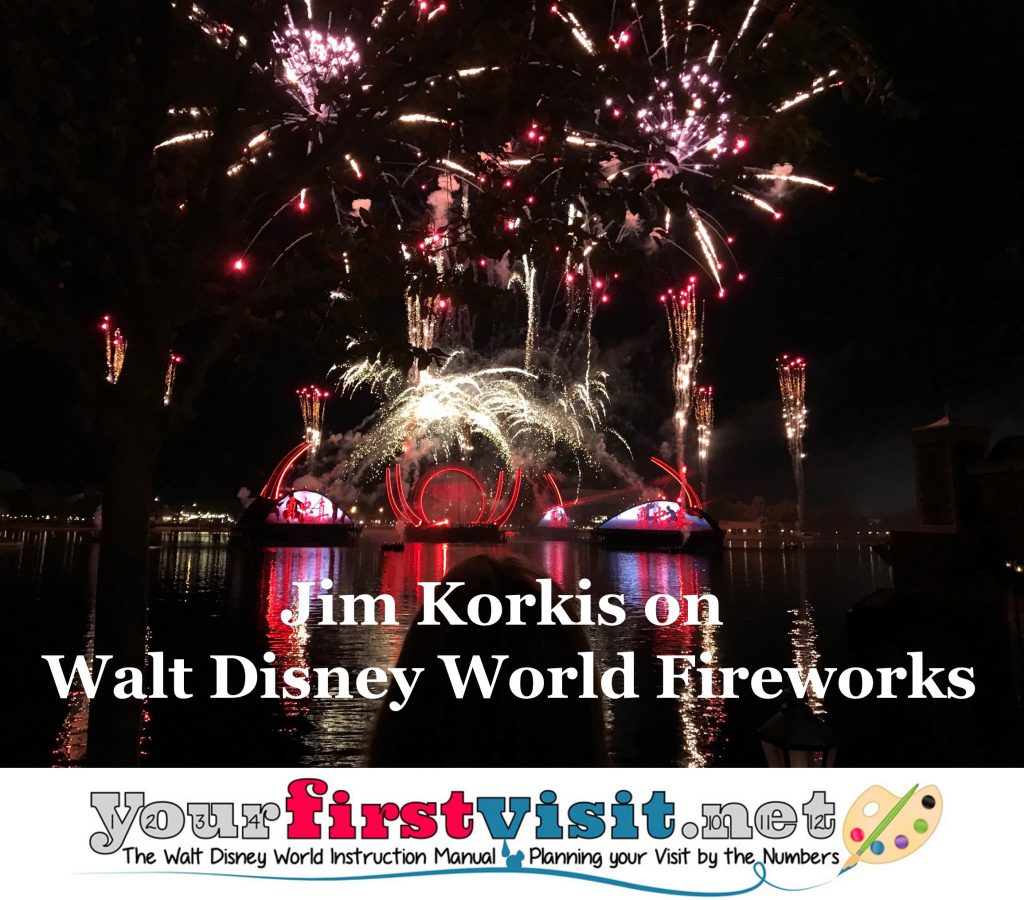
“When making the initial design for a show, careful consideration must be given to product selection,” stated Brad Cicotti principal Special Effects designer. “Working with Safety & Heath, this is achieved by performing numerous live tests of hundreds of fireworks items. Familiarity with the parks and their operation and, most importantly, knowledge of how the firework product will react when it is fired are critical.”
Entertainment Fireworks crews work on more than a half dozen Operation shows daily, some performed multiple times. Before the pandemic shutdowns occurred, teams also worked on over 350 special events annually including holiday celebrations, weddings and conventions.
At the Walt Disney World Resort, fireworks are not lit by hand but are ignited electronically. The product is “matched” by an electric igniter. For large shows, the electric igniter goes into a computerized firing system controlled by a pyrotechnician. The pyrotechnician monitors the computer status, the performance of the fireworks, weather conditions, and site security.
Starting in 2004, to launch the projectiles Walt Disney World uses a compressed air system that ensures a higher launch with greater accuracy and consistency, as well as reducing unwanted noise. The compressed air system also eliminates launch-related gunpowder fumes. Since fireworks do indeed still burn, guests may smell fumes, but fewer of them.
As a means of fire prevention at the Magic Kingdom Park, a sprinkler system irrigates the area surrounding the firing site before the show is performed. The rooftops in Fantasyland where more pyrotechnics are launched also are watered down before the fireworks are launched in order to minimize fire risk.
“Safety is a part of every step of the process,” said Doug Madill, Entertainment Operations manager of the Fireworks Storage Facility, “from the technical training our Entertainment Cast Members receive, to the show design, to the storage and delivery of the product and finally the actual show.”
Only Disney’s Animal Kingdom does not have a fireworks, show because it was determined that the loud noises would bother the animals and disrupt their sleep schedule.
Walt Disney World parks change their fireworks offering regularly, constantly trying to “top” previous shows in terms of visual display, music and more. The nighttime park shows last roughly fifteen minutes or a little more.
* * * * *
Thanks, Jim! And come back next Friday for more from Jim Korkis!
In the meantime, check out his books, including his new books Vault of Walt: Volume 10: Final Edition, Kungaloosh! The Mythic Jungles of Walt Disney World and Hidden Treasures of Walt Disney World Resorts: Histories, Mysteries, and Theming, much of which was first published on this site.
Follow yourfirstvisit.net on Facebook or Twitter or Pinterest!!
March 18, 2022 No Comments


